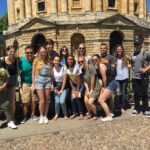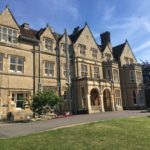Today we had our first presentation on John Henry Newman and the locations around Oxford that were connected to him: Brasenose, Lincoln, All Souls and The Queen’s College, We also heard about the building of the Radcliffe Camera, the first round library. The themes the group explored were:
- the shifts in religious fervor, here but also in the US
- why Newman attracted young students to his sermons and the changing face of Roman Catholicism today
- the architecture of colleges: shutting one out vs. inviting one in–again some interesting contrasts between here in Oxford and our experiences of colleges in the US
- role of identifying with one’s college and how that signifies vastly different connotations
After our class session we went on a guided tour of the Bodleian Library. Our guide
assumed a audience of devout Harry Potter fans and indeed some of the group resonated with her references. We were caught by with Duke Humphries’ Library with its ancient texts, chained to the bookshelves, and the bordering on religious atmosphere of entering the holy of holies to get into the readings room. Downstairs the Divinity School room offered a phenomenal ceiling which pulled together the earthy (the benefactors who helped pay for its construction) and the heavenly (the statues and symbols associated with Christianity.
Afterwards our team led us to University Church, St. Mary’s, where we noted the gorgeous stained glass windows at one end and the clear class of the Reformation at the altar end. Here Archbishop Cranmer was accused and sentenced to death for refusing to return to Roman Catholicism under Queen Mary.
Today was a day to contemplate the changing face and passion of religion as well as to reflect on the role of education and how the educational systems differ here and in the US.









